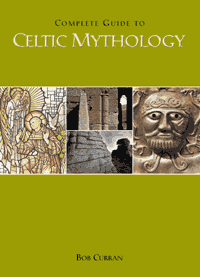 |


|
|||
 The Supernatural Forces of Celtic Belief When considering the deities of the ancient Celtic world, we are faced with something of a dilemma. The fragmentary nature of its society and religion precluded a cohesive, structured and unified pantheon of deities such as the mythologies of Rome and Greece. Celtic religion was more a complex configuration of tribal and localised cults rather than a national faith. Where a semblance of unified structure existed, it usually reflected a fusion of Celtic and Hellenic or Romanised gods. There are elements of Scandinavian mythologies in later Celtic legends from increased contact with the various cultures of the ancient world. The Romans believed that all nations and cultures worshipped the same gods that they did but with different names and attributes. Thus it is not surprising that many of the gods of the conquered Celtic peoples had their names changed into Latin equivalents – Apollo, Jupiter, Minerva, etc. – and that their attributes were altered to fit the specific Roman god after whom they were named. When Caesar listed the most popular Gaulish deities in his Gallic Wars, he naturally amended their names. It is believed that Mercury refers to Lugus, a god of light, whose cult centre Lugunum – Fort of Lugus – became the capital of Roman Gaul and whose feast day, 1 August, became the festival of Augustus. A British healing goddess, Sulis, became identified with the Roman goddess Minerva, becoming the composite Sulis Minerva worshipped primarily at the healing spa of Bath, later an important Roman city. Of course, Romans and Celts might have had a common Indo-European origin, which would have formed the basis of shared myth-patterns and common attributes for their gods. This made the process of Romano-Celtic amalgamation relatively easy. But these composited gods and goddesses make any study of pure Celtic religion doubly difficult. The earliest form of worship among the Celts was probably an animistic religion, common in many ancient peoples, including the Semites – forerunners of the Hebrews. This saw the workings of vaguely specified spirits and forces reflected in nature generally. Deities dwelt in rocks and trees, in standing stones and in rivers and wells, and their influence could extend beyond the physical confines of these locations. A well spirit, or tree spirit, might create fierce windstorms or cause the crops to fail if not placated. This type of worship is reflected in the ancient religions of both Scotland and Ireland, perhaps because of the spectacular landscapes of these places. In addition, many of the Celtic clans venerated tribal protective or hunting spirits, often embodied in the form of wild animals - deer, bulls, horses etc. These deities guaranteed sufficient animals to hunt, and imbued warriors with strength to defend their settlements against attack. These protective spirits tended to be associated with strong and wild animals - boars, bulls and horses, all widely regarded as symbols of strength and virility. The Celts made little distinction between the gods and the animals that represented them and many of the gods took on animal characteristics. Lastly, some of the spirits were strongly associated with fertility. As the Celts settled Western Europe the notion of fertility became paramount in their religion. It was essential that the crops continued to grow from year to year, and that the cattle and sheep continued to produce young. It was also essential that the tribes themselves continued to grow and expand. The Celts had not fully abandoned their warlike nature, and their tribal history is filled with stories of cattle raids or attacks on other communities. It was essential that a healthy population of young men to act as warriors existed to defend against such raids (see Ancient Heroes). Offerings were frequently made to local spirits to ensure fruitfulness throughout the coming years. Fertility worship highlighted the passing seasons for the Celts, and they began to consider their year in terms of festivals associated with growing and harvesting of crops, and the raising of livestock (see The Great Wheel of Existence). All the while brooding spirits watched over them, weighing their every move and judging their every action. Caesar, commenting on the inhabitants of Gaul, states that they were ‘an extremely religious people’. For the ancient Celt, then, spirits and gods were everywhere. The Landscape In many Celtic countries, the landscape is spectacular. It can be mysterious and threatening and must have affected the early Celtic settlers. The lands of the West were shaped by the Ice Age. Great boulders and heaps of stones, moved by mighty glaciers and ignominiously dumped by the departing ice, lay everywhere. Many of these great megaliths must have been suggestive of either giants (see Giants, Monsters and Fairies) or superhuman/supernatural entities. The earthworks and stone circles of aboriginal races were treated with wonder, as the habitations of strange and unearthly beings. They rapidly became the objects of worship and a focus for localised religion. The distinction between giants and gods became blurred. In Ireland, Scotland, Wales and Cornwall, are great earthworks, enclosures or stones known locally as giants’ graves, reputed to boast supernatural powers well beyond the province of any gigantic man. Stones were important to the ancient Celts. They were used for building, as bound162 ary and as memorial markers and it is not surprising that they became the habitation of mysterious spirits and that strange powers were ascribed to them. In Brittany, a persistent tradition told that the druids used these stones to focus Otherworld powers, in order to create storms and diseases in our own world. Many large stones, particularly great, singles stones, were the object of druidical worship, and associated with the fertility sects.The configurations of the stones also puzzled the Celts. They were arranged in a number of ways. There were Inger stones jutting out of the earth like a warning finger and stone circles. There were rocking stones: a flat stone resting on the top of another either a natural phenomenon or the work of prehistoric engineers, dolmens and cromlechs. These latter were known as Fos-Leac in Ireland, traditionally the burial-site of a local chieftain or hero and, later, of a saint. They consisted of two upright stones surmounted by a capstone. Many stones had special powers that formed the beliefs of the local communities. In Brittany, it was believed that an infertile woman who sat astride the capstone of a dolmen would conceive within the year. While in Ireland, a couple who kissed a Kissing Stone at the same time would find their love would last forever. (For these and other such beliefs see Bonwick: Irish Druids and Old Irish Religions, 1894.) It was John Aubrey, in the 17th century, who first linked the standing stones with druidical temples, although there appears to be little evidence for such a connection. Professor Joseph Anderson has observed in his Scotland in Pagan Times: ‘…in the end of the seventeenth century, there was no tradition among the people connecting these places with the druids. They were simply regarded as places of pagan worship.’Even if the Celtic holy men did not raise the standing stones and stone circles, they used them within their religion. Some of the single standing stones had the shape of an extended phallus and conformed to the overall Celtic preoccupation with fertility religions. The medieval writer Jocelyn of Furness refers to many of these as ‘druid stones’ which had pagan and fertility associations. Such stones could also be used for human sacrifice. On the north Antrim coast, on the northerly tip of Ireland near the town of Portrush, a lone stone rears up in the middle of a field overlooking the sea. It is known locally as the Clogh Ór and lends its name to the land around. There is little doubt it was used, like the Crom Cruach in County Fermanagh (see The Druidic Tradition), for infant sacrifice which was thought to restore health and vigour to the ground and to secure the harvest for another year. It was a sacrifice to the spirit that dwelt in the stone. The stone was venerated as a living embodiment of the god. In many areas, there were a variety of Cloch Ór – Golden Stones – that might have been used for similar purposes and which were said to contain spirits. It was believed that, in order to take away its heathen power, a stone in County Tyrone was placed within the precincts of Clogher Cathedral, which then reputedly took its name from the stone. In 1699, an old man was arraigned before the Kirk Session in Elgin, Morayshire charged with idolatry. He had apparently set up a large standing stone near his house and raised his cap to it (See: Evan Hadingham, Circles and Standing Stones, New York, 1976). He was not alone. The 18th-century writer Thomas Pennant, while travelling in Scotland, noted that many country people left offerings or gave some sign of veneration as they passed certain stones, reputedly the ‘resting places’ of ancient gods. On Dartmoor, veneration was shown in past times to a stone known locally as the Bowerman's Nose which stands on Hayne Down near Manaton (See: Ruth E. Saint. Leger-Gordon, The Witchcraft and Folklore of Dartmoor, 1994). The word ‘Bowerman’ almost certainly comes from the ancient, Brythonic Celtic vawr-maen meaning, ‘great stone’, and, although not raised by the druids, was probably venerated by them. Tales of both Dartmoor and Bodmin Moor concerned stones that moved and came down to nearby water to drink during the hours of darkness. In the Celtic mind, this gave them a ‘life-like’ quality that agreed with the notion of animated spirits. Trees also formed an important part of Celtic worship and many sacred groves were religious sites. The ancient perception of trees in such places may have given them a particularly sacred significance. Trees were associated with storms and lightning, perhaps because storms would centre around isolated trees. Those struck by lightning would bear growths and this is why mistletoe is known as Donnerbesonn – thunderbroom in Switzerland. Trees were also pillars that stretched from earth to sky, into the realm of the gods/spirits. From earliest times men looked on trees as a bridge between the two realms. It is even speculated that early men placed their dead on an upturned tree so that birds could peck their flesh and that they could be hastened on their way into the Afterlife/Otherworld. (For the Christian symbolism of the upturned tree see Legends of Saints and Holy Men). Solitary trees in particular often resembled grand columns stretching to the sky. Powell (The Celts, 1958) postulates that for the Celts, lone trees represented a cosmic pillar on which the spirits could travel to visit their worshippers below. He goes on to speculate that the Jupiter-columns of Classical temple architecture would originally have been wooden, and perhaps there would have been a sacred, live tree growing within the temple precincts. Certainly, Celtic tree worship combined well with the perceptions of many other ancient faiths. The oak was sacred to the Roman gods Jupiter and Mars, and sometimes to Woden, the supreme Norse god. At some point, the Celts started to worship trees in their own right. There are a number of sites, particularly in Ireland, that suggest trees were worshipped there. Magh-Bhile – Moville, in County Donegal – means the Plain of the worship of the old tree, Derry, is derived from the name Doire or Dair meaning oak-tree; Kildare from Cill-Dara, the ‘church’, or ‘cell, of the oak’. Superstitions were attached to these trees, in particular the lone trees that provided a bridge between the spirit and mortal worlds, and great harm could befall anyone who meddled with them. There were beneficial effects to be had from the leaves of certain trees and the druids, in their capacity as healers, would have used them to good effect, acquiring their Celtic nickname, Dairaoi – dwellers in the oaks. Magical properties attached themselves to the quicken-tree – also known as quickbeam, rowan or mountain-ash – that supposedly had the power to banish all evil spirits, including phantoms of the dead, witches and the ‘fairy kind and minor devils’. It was no coincidence that the great Celtic sage Merlin reputedly transformed himself into an oak-tree when nearing the end of his days and while mourning the loss of his consort Vivian, or Morgan Le Fay in some tales. The oak later became the symbol of the island of Britain itself. The Bible mentions the Tree of Knowledge in the Garden of Eden and others were common in the mythologies of many ancient peoples, including the Celts. The merging, by Christian writers, in the tale of Adam and Eve of the twin symbols of paganism, the tree and the serpent, is highly significant. In parts of France, the identification of trees with a local god was very common. In the French Pyrenees, locals worshipped the god ‘Fagus’ – the name means ‘beechtree’ – and made offerings of food, weapons and sometimes human life to groves of beeches. Even today in parts of the Celtic world, most notably in Ireland, Scotland and England, trees are regarded with a mixture of awe and superstition. And there are people who will refuse to cut down or tamper with a lone tree for fear of angering ‘the fairies’ or ‘the old gods’. It seems that the roots of tree superstition go deep. Rivers and wells were also venerated by ancient societies. Both the pre-Celts and Celts viewed rivers and streams as a focus for their ritual practices. From as early as the middle to late Bronze Age – about the middle of the second millennium bc – European tribes cast items into them as offerings to the supernatural forces that dwelt there. Most of these items were pieces of ornamental metalwork – including valuable golden amulets and torcs – but some were swords and axes, offerings, perhaps, for victory in battle. Body-armour and shields such as the Battersea Shield and the Waterloo Helmet have been recovered from the River Thames. In Gaul and Brittany, the Marne took its name from Matrona – all-mother – who was said to live beneath its surface, and the name of the Seine is derived from Sequana who dwelt at the source of the river and was supposed to have healing abilities. Consequently, in the ancient world, the waters of the Seine were alleged to have therapeutic properties. The sanctuary of the goddess at Fontes Sequaine, in the northwest of Dijon in Burgundy, was later taken over by the Romans as a healing spring. In some cases, the offerings of human life were made to placate the river and lakegods and prevent flooding. The Irish Annals of the Four Masters noted that a child was sacrificed each year to the River Bann at a ritual site near present-day Coleraine to prevent the river from bursting its banks. The site of the confluence of rivers was almost invariably a sacred spot. At the confluence of the large rivers Rhône and Soane outside Lugdunium – near Lyon – the Imperial Cult of Rome and of Augustus was established in ad 12. A large altar was set up directly beside the confluence and was inscribed with the names of sixty Gaulish tribes. The ceremony of establishment itself was, interestingly, presided over by a Celt – the chief priest of the Aedui – and the date of the ceremony coincided with the Celtic festival of Lughnasa. The ritual drowning among the Celts of vanquished enemy leaders also suggests offerings to lake and river gods. It was, reputedly, a greater gift if the vanquished leader came from another race or creed, such as the ‘death by submersion’ of the Viking leader Turgeis by the High King of Ireland in the mid-ninth century. There are suggestions that Vikings might, infrequently, have carried out ritual drownings. The drowning in a bog of one of the O'Flynn chieftains of the Shiel Casuthaigh – a tribal group with territories in north Antrim – by ‘black foreigners’, perhaps Danes, early in the eighth century was a case in point. (see: William Adams, The Kingdom of Dalriada, 1906). This Chapter extract continues with Spirits of the Earth and Air - Part 2>>>.
From Complete Guide to Celtic Mythology by Bob Curran |
[ Back to top ]
All Material © 1999-2006 Irelandseye.com and contributors

